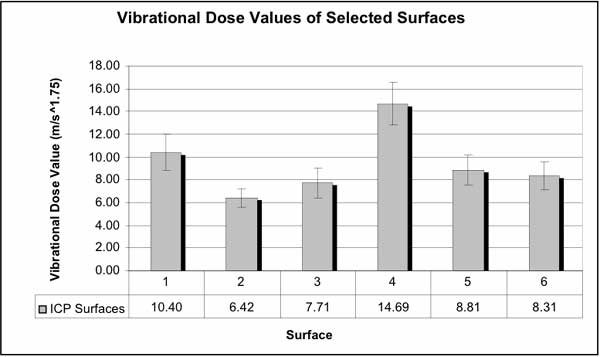ASSESSMENT OF VIBRATIONS DURING MANUAL WHEELCHAIR PROPULSION OVER SELECTED SIDEWALK SURFACES
ABSTRACT
Interlocking Concrete Pavement (ICP), in a paper by the United States Access Board has been deemed undesirable in pedestrian access route because of vibration that may be caused to manual wheelchair users. The purpose of this study was to evaluate the vibrations experienced while traversing ICP. Ten unimpaired participants propelled a rigid frame manual wheelchair over a poured concrete surface, three ICP surfaces and two brick surfaces. Significant differences were seen between the six selected surfaces.
BACKGROUND
Over the course of any given day wheelchair users encounter obstacles such as bumps, and uneven driving surfaces that cause vibrations on the wheelchair and in turn, the wheelchair user. Due to the extended exposure of vibration that wheelchair users experience, harmful effects to the body can occur such as low-back pain, and disc degeneration [1].
Studies have shown correlations between whole-body vibrations and secondary injuries in occupational settings. The trucking, and construction industries, as well as bus drivers and farmers, have shown relationships between exposure to whole-body vibrations and secondary injury [2][3].
The International Standards Organization (ISO) [4] and the American National Standards Institute developed a standard for whole-body vibration measurement. It includes the amplitudes of vibrations that are considered harmful and the exposure times for vibrations to be dangerous.
RESEARCH QUESTION
The purpose of this study was to record and analyze the vibrations that occur on a manual wheelchair user while traversing selected sidewalk surfaces in a manual wheelchair. The study should provide support for determining the criteria for defining a wheelchair pedestrian access route that does not expose wheelchair users to potentially harmful vibrations.
METHODS
Ten unimpaired individuals propelled a manual wheelchair over six pavement surfaces during data collection. Surface 1 was a poured concrete sidewalk with a brushed finish, which represented the control. Three of the remaining surfaces were constructed of interlocking concrete pavement and the final two were fired clay brick. The three ICP surfaces were installed in a 90-degree herringbone pattern and had squared edges, a 3.2mm beveled edge, and a 6.4mm beveled edge respectively. The final two surfaces were arranged in a 45-degree herringbone pattern and had squared edges and a 3.2 mm beveled edge respectively. A rigid frame manual wheelchair was used to collect data from the sidewalk surfaces. Vibration data were collected from the seat and the footrests of the wheelchair while the subject propelled over the surfaces a total of 18 times in a randomized order. Subjects propelled the test manual wheelchair at 1 m/s for each of the tests.
The collected acceleration data represents the vibrations that are experienced at the seat while traversing each of the sidewalk surfaces. The variable of interest in this study was the vibrational dose value (VDV), as described in the ISO 2631-1 Standard of Human Vibration. Simply, it is the collected vibration experienced by the participant, weighted in accordance to the ISO 2631 standard, taken to the fourth power, summed and taken to the one-fourth power:
where (aw) represents the weighted vibrations from each trial. The VDV is used in practice because of its simplicity as well as its significance.
Statistical analysis was performed on the collected data to determine if differences existed between the vibrational dose values of the six sidewalk surfaces.
RESULTS
A one-way ANOVA of the data showed significant differences between the surfaces (p<0.05). Post Hoc analysis revealed that surface four (90-degree herringbone pattern with a 6.4 mm beveled edge) was significantly higher than all other surfaces and surface one (poured concrete surface) was higher than all surfaces except surface four. Surface two (90-degree herringbone pattern with squared edge) was significantly lower than all other surfaces.
 |
DISCUSSION
Results from the statistical analysis showed surfaces one and four recorded statistically higher vibrational dose values. Based solely on using the vibrational dose value as a measurement criteria for vibration exposure, results show that surfaces two, three, five, and six, which are ICP surfaces are acceptable for pedestrian use. Other types of data analysis done in other studies, namely analysis in the frequency range show similar results where these same surfaces are similar to the poured concrete in their vibration exposure.
Future studies need to examine a broader range of sidewalk surfaces. Cost analysis studies might also be conducted to determine if the cost benefit of using an ICP surface as opposed to the traditional poured concrete surface is viable. Studies also need to be conducted using experienced wheelchair users as subjects. A standardized wheelchair could be used in future studies, where the study of participants in their personal wheelchairs would provide results that could be appropriately generalized.
CONCLUSION
When treating the poured concrete sidewalk as the normative standard, surfaces two, three, five and six performed as well or better in terms of shock and vibration exposure whereas surface 4 produced worse results. Surfaces 2, 3, 5 and 6 should be considered acceptable as a pedestrian access route for wheelchair users.
-
Seidel H, Heide R, Long term effects of whole-body vibration: a critical review of the literature, Int Arch Occup Environ Health, Vol 58, 1986; 1-26
-
Dupuis H, Hartung E, Haverkamp M, Acute effects of transient vertical whole-body vibration, Int Arch Occup Environ Health Vol 63, 1991; 261-265
ACKNOWLEDGEMENTS
This study was partially funded by a consortium of the Interlocking Concrete Pavement Institute (ICPI), Brick Industry Association (BIA) and the National Concrete Masonry Association (NCMA). In addition, funding was provided by the VA Rehabilitation Research and Development Service, Veterans Health Administration, U.S. Department of Veterans Affairs (F2181C), and the U.S. Department of Education, National Institute on Disability and Rehabilitation Research (NIDRR) Rehabilitation Engineering Research Center on Wheeled Mobility (H133E990001).
Erik
Wolf
7180 Highland Drive, 151R - 1,
Pittsburgh, PA 15206
Phone: 412-365-4850
Fax: 412-365-4858
ejwst11@pitt.edu
 [1]
[1]